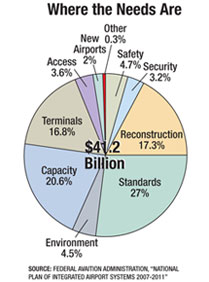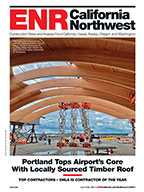As Congress prepares to reauthorize aviation programs next year, there are plenty of airport projects on tap that can use federal funds. A new Federal Aviation Administration report estimates airports will have $41.2 billion in infrastructure work eligible for federal aid over the next five years. That total in the study, the latest update of FAA's National Plan of Integrated Airport Systems, represents a moderate 4% gain over the estimate in the report issued in 2004, and 11% below the 2002 study's $46.2 billion, which reflected pre-9/11 data.
| + click to enlarge |
 |
Michael Steer, director of air transportation for engineering firm URS, says he's not surprised at the FAA's findings. He says that although passenger traffic has rebounded since the 2001 terrorist attacks, "There still seems to be the lack of urgency that was there in the late '90s" for airports to add capacity. "They've just been a little more cautious," Steer says.
FAA's latest study, sent to Congress Sept. 29, shows that fast-growing sectors include pavement reconstruction, up 40% from 2004's report, to $7.1 billion; security, which rose 91%, to $1.3 billion; and runway safety work, up 45%, to $1.9 billion. New runways and other projects to boost capacity also climbed 12%, to $8.5 billion. FAA says four new runways, one extension and an airfield reconfiguration are under way and seven other projects are in planning or environmental review phases.
The largest sector is working to bring airports up to FAA design standards, pegged at $11.1 billion. But the total for that category, which includes taxiways and parking areas to handle current aircraft types, declined 21% from 2004.
The FAA report only counts projects eligible for federal Airport Improvement Program grants. They exclude such construction as automobile garages and areas of terminal buildings that produce revenue, such as shops and restaurants.
The report will be a resource for lawmakers as they draft a successor to 2004's Vision 100-Century of Aviation Reauthorization Act, which carries FAA programs through fiscal 2007. The new aviation measure is "one of the big construction bills in the next Congress," notes Brian Deery, senior director of the Associated General Contractors' highway and transportation division. Congressional committees "always look to those kinds of reports from the government as sort of a barometer of what the real needs are out there."
"Vision 100" authorized $14.2 billion for AIP over four years. Industry will be seeking more in next year's bill. Says Todd Hauptli, senior executive vice president of the American Association of Airport Executives: "What the new [FAA report] results show is that the needs for airport infrastructure investment far outstrip available federal resources."


Post a comment to this article
Report Abusive Comment